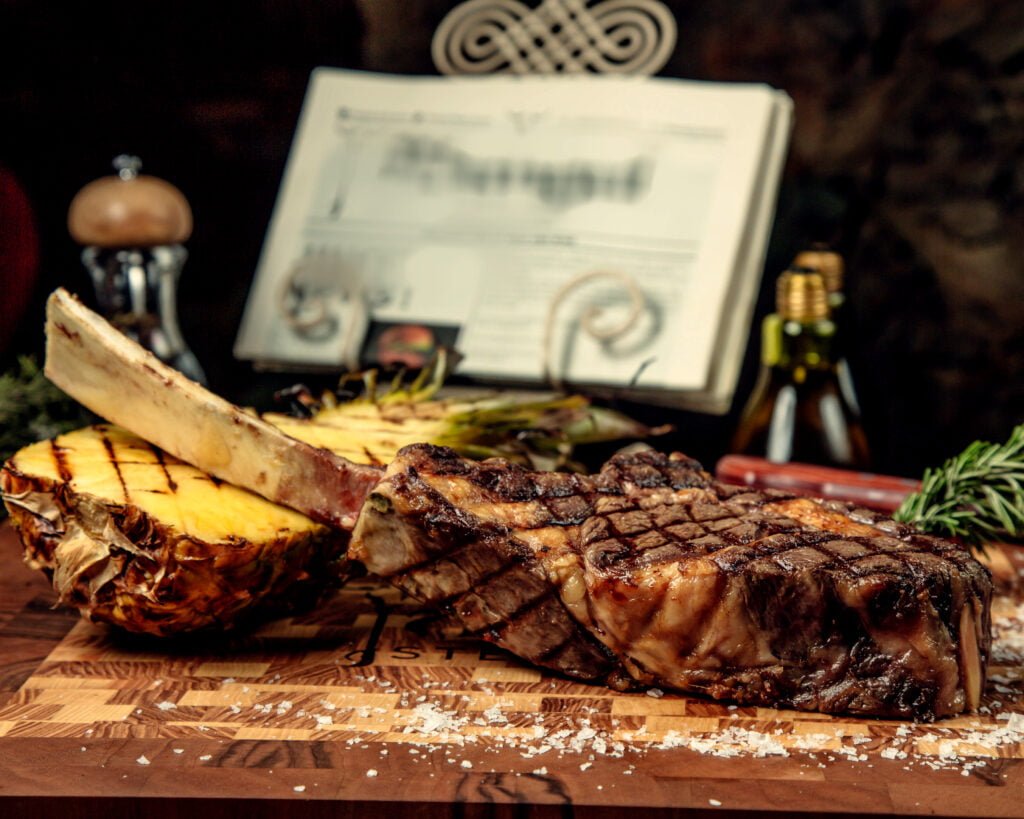How to Open a Steakhouse Restaurant?

Introduction
The global steakhouse market is booming. Estimated, it will grow at a 5.2% CAGR from 2023-2028. The major contributing factors are the high-quality dining experience and premium-quality meat product demands. Therefore, restaurant owners’ central focus is incorporating the latest technology with sustainable practices and customer-oriented approaches.
In 2023, although there were a lot of economic challenges, the full-service restaurant industry generated around $975.9 billion in sales. The credit for this resilience goes to digital ordering and modern point-of-sale technologies with the latest loyalty programs. About 39% of restaurant owners plan to practice more sustainable techniques to stay competitive. They will do so through compostable packaging and sourcing their local ingredients. They will reduce food waste by utilizing imperfect produce.
Ideally, you can excel in this business by using technology and sustainable practices and making your customer services exceptional. Let’s explore in detail how to open a steakhouse restaurant.
How to Develop a Steakhouse Restaurant Business Concept?
To develop a business concept, you must define your values, vision, and mission and conduct the best market research.
Define Your Vision:
First, you must define your vision for a steakhouse, such as what is trending in the market and what consumers prefer. Today, the most popular concepts are:
- Traditional Steakhouse
- Modern Steakhouse
- Boutique Steakhouse
- Family-Style Steakhouse
- Barbecue Steakhouse
- Farm-to-Table Steakhouse
- International Steakhouse
- Combination Concepts
Market Research:
Thorough market research is crucial to creating an ideal business plan. It will help you identify your target audience. You will analyze competition in your local market and identify trends and consumer preferences.
Unique Selling Proposition (USP):
Your USP is just like your signature; no one can provide it. Some ideas for the USP are:
- Signature Dishes that become synonymous with your brand.
- Exceptional Service to provide a memorable dining experience.
- Ambience and Design to create a unique and inviting atmosphere.
- Sustainability is achieved by sourcing local ingredients and environmentally safe packaging.
- Exclusive Events to attract and retain customers.
- Technology Integration to enhance the dining experience.
How to Create an Effective Business Plan for a Steakhouse Restaurant?
While planning your business, keep the following factors in mind:
Executive Summary:
First, prepare an executive summary to create an effective business plan. It will include the concept of your restaurant, such as your focused and core services; your business mission, such as the aim of providing extraordinary dining services while prioritizing sustainability; and your vision, such as the desire to be known for your commitment to quality, etc.
Market Analysis:
The second step is the market analysis. Each year, the USA restaurant market is growing by around 4.5%. Although this growing demand is a positive gesture for the new businesses simultaneously, it also indicates the competition.
So, you need to set a target demographic for your business, like your primary target audience being wealthy professionals and tourists or those who love quality foods. In that way, you will already know the budget criteria you can set for your dishes.


Menu Planning:
Now, plan your menu, including your restaurant’s signature dishes, which stand out for their uniqueness in taste and quality, trending dishes like farm-to-table options, seasonal ingredients, or specific beverages. You should deal with customer preferences, analyze their feedback, and conduct regular taste tests.
- Business Registration: The first legal requirement is to complete business registration with a General Business License. You will get it from any Government office. An Employer Identification Number is crucial, which you can get from the IRS.
- Health and Safety Regulations: You must get a Food Service License. Other health department permits and Certificates of Occupancy are mandatory to avoid any legal consequences in the future.
- Insurance: You must complete some insurance to protect your business against claims. You will need liability insurance and property insurance. However, worker’s compensation insurance is also necessary.
- Additional Permits: If you are providing beverage-related services, you may also need a Liquor License and a signed permit from the local government.
How Can I Choose the Right Location for My Steakhouse Restaurant?
Choosing the right location and design depends upon the following three factors:
Site Selection:
While choosing a site, remember that it should be easily accessible by any public transport. Also, ensure you open your restaurant in the right place for the target audience. There should be less competition and a market gap in the area.
Otherwise, too much competition will trouble and discourage you. You must comply with Zoning Laws.
Interior Design:
Choose sustainable and eco-friendly materials, integrate technology, and keep the design biophilic by incorporating living plants at different places. Remember, an open kitchen with a beautiful layout attracts more diners. Never neglect the localized and cultural themes in your restaurant.
Kitchen Layout:
Design an optimized layout that reduces movements while increasing efficiency. You can design in a U-shape or L-shape or a gallery kitchen.
Remember, strategically placed equipment and proper storage solutions for everything will boost your productivity and speed up the cooking process.
What are the Key Elements of a Successful Steakhouse Menu?
The key elements of every business can be its signature product and product quality. In the restaurant case, your signature dishes, your menu testing method, and how you source the ingredients will play a key role.
Signature Dishes:
These dishes are crucial for your restaurant’s unique identity and attract repeat customers. So, you need to innovate your signature dishes with unique recipes, sourcing, and a touch of local ingredients. Your presentation matters a lot, so make it highly visually appealing. Besides these, be focused on the customer’s favorite dishes as well.
Sourcing Ingredients:
Make sure you are ethically sourcing the quality ingredients. Always prefer to buy from local suppliers to get fresh ingredients. It will also contribute to your country’s economy. Make sure your sources are diverse to ensure a consistent and fresh supply.
Menu Testing:
Menu tasting plays a key role. You can conduct taste tests to refine your menu. This will boost customer satisfaction and ultimately bring in more clients while maintaining the present ones. You can do menu testing by creating prototypes, customer sampling, focus groups, and iterative testing.
What are the Best Practices for Hiring and Training Staff for a Steakhouse Restaurant?
Some of the best practices include:
Hiring:
Ensure that the right team is hired for your business. To do so, you need to define the roles clearly, use multiple recruitment channels to find the best fit, screen the candidates thoroughly to find the hidden capabilities, and offer competitive compensation, as good remuneration attracts top talents.
Training:
After hiring the team, you must train them according to your restaurant culture, cooking styles, and the dishes you present. You can train them through onboarding programs, hands-on training, providing them continuous learning, and getting feedback from your consumers.
Team Culture:
Make sure your restaurant team culture should be positive. You can create this culture by articulating your values to the team, communicating with them clearly about everything, like your vision, mission, and values, educating them about the best practices for humanity, and building a family environment. You should recognize their efforts and reward them accordingly. You should also promote a work-life balance. Conducting some team activities is also crucial.
How Can You Effectively Market Your Steakhouse Business to Attract Customers?
There are three significant ways to market your business effectively. They include:
- Branding includes a name and logo. The name should be memorable, and the logo should be attractive. Branding also consists of an attractive brand story that aligns with the target audience’s emotions and feelings. It also includes a consistent visual identity, uniform color schemes, and typography.
- Online Presence: Today, having a digital presence is mandatory for every business. You need to develop a website based on the theme of your restaurant, social media profiles associated with this website that promote your business regularly, and online reviews and listings about your products. You can also use email marketing for targeted promotions.
- Promotions and discounts help attract new clients quickly. You can organize grand opening events and offer special promotions. Loyalty programs and seasonal and themed events are also great ways to attract users. Promotions and discounts will play a crucial role in promoting your business.

Looking to start or expand your Steakhouse Business ??
With 10+ years of experience as business growth consultant, We have worked with hundreds of companies just like yours on many similar projects (helping to raise finance between £30,000 and £5 million).
Book free consultation now! to discuss your project needs and how we can help you achieve them.
How to Manage Operations for Your Steakhouse Restaurant Business?
To manage your business operation so effectively that it yields a revenue boost, follow the strategies below:
Inventory Management:
It helps reduce waste. It includes practices like implementing inventory management software, setting PAR levels, using First-in, First-Out (FIFO) methods, regular audits, and establishing supplier relationships.
Customer Service:
Provide exceptional training and skills to your staff through comprehensive training programs and regular sessions, empower them to make decisions, and provide them with regular feedback about their growth.
Feedback Mechanism:
You can get continuous customer feedback by conducting online surveys and reviews, filling out feedback forms, and engaging users through your business’s social media profiles.
What Are the Best Practices For The Financial Management of Your Steakhouse Restaurant?
It is the most crucial part of your steakhouse restaurant business. Follow the below practices to get the best results:
Budgeting:
You should plan your budget effectively to manage expenses. To do so, you should track the financial data, estimate the revenue and expenses, control the major expenses you can, and maintain a continuous fund.
Pricing Strategy:
Always ensure your menu prices are right according to the quality and target audience. Some effective strategies include:
- Cost-Plus Pricing: The cost of each dish plus some markup cost.
- Dynamic pricing is based on demand, time, or a particular day or event.
- Psychological Pricing is just below a round number, e.g., &19.99 instead of &20.
- Menu Engineering: Prefer high-margin items and remove or re-pricing low-margin, low-popularity dishes.
Conclusion
That’s how you can open a steakhouse restaurant. It’s an interesting business as you meet different people, serve them food, and make them feel happy. Ultimately, you get both happiness and wealth. Just follow the guidelines mentioned in this article and start your business today.
Remember, your team will be your core strength. So hire those who are passionate, eager to learn new dishes, and make you feel like your family. Such a team will boost your revenue very fast, and it will happen when you create a positive environment for your team and encourage them to try new recipes confidently.
Frequently Asked Questions (FAQs)
A
A successful steakhouse menu generally has the best steaks, a variety of cuts to pick from, appetizers, side dishes, desserts, and drinks like cocktails.
A
Obtain meat from trusted suppliers, put money into the right storage and preparation facilities, and train your kitchen staff on how to cook it properly.
A
Provide competitive salaries, training programs as well as career development possibilities; create a friendly working environment and reward good performance among staff members.
A
Some frequent challenges include cost control measures, preservation of standards regarding quality, competition management, and customer satisfaction assurance among others. Monitor your budget; train staff; differentiate yourself; look for feedback constantly.
A
Comment cards, online reviews, social media, or direct conversations with customers are some of the methods. Reviewing such comments regularly should become part of your routine.
A
Address complaints promptly and professionally, apologize if necessary, offer solutions, and use the feedback to improve your service and operations.



